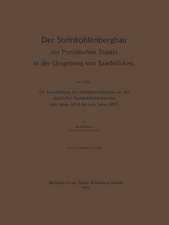Sorbents Materials for Controlling Environmental Pollution: Current State and Trends
Editat de Avelino Nunez-Delgadoen Limba Engleză Paperback – 19 feb 2021
The growing concern regarding soil, water and air pollution all over the world has implications for climate change and sustainability, making Sorbents Materials for Controlling Environmental Pollution: Current State and Trends an important reference for environmental scientists to identify tools for moving forward in solving these problems.
- Includes data and examples from various geographic locations worldwide
- Synthesizes data for a variety of sorbent material from different sources
- Presents data for various kinds of pollutants across environmental spheres, including soil, water, and air
- Utilizes an interactive table for quicker access to data and results
Preț: 863.22 lei
Preț vechi: 1121.30 lei
-23% Nou
Puncte Express: 1295
Preț estimativ în valută:
165.17€ • 172.47$ • 136.40£
165.17€ • 172.47$ • 136.40£
Carte tipărită la comandă
Livrare economică 08-22 aprilie
Preluare comenzi: 021 569.72.76
Specificații
ISBN-13: 9780128200421
ISBN-10: 0128200421
Pagini: 776
Dimensiuni: 191 x 235 mm
Greutate: 1.31 kg
Editura: ELSEVIER SCIENCE
ISBN-10: 0128200421
Pagini: 776
Dimensiuni: 191 x 235 mm
Greutate: 1.31 kg
Editura: ELSEVIER SCIENCE
Public țintă
Researchers in pollution management, environmental remediation, and environmental scientists working in a variety of disciplines including water treatment, soil remediation, and air pollution.Environmental Engineers, Chemical Engineers, researchers of nanomaterials
Cuprins
1. Introduction
Part 1: Global Case Studies
2. Data on the use of sorbents to control pollution in Europe, with main focus on Spain and Galicia
3. Sorbents of heavy metal contamination: Research progress within an Australian context
4. Low-cost sorbents for metal(loid)s removal from mine effluents: an Andean region perspective
5. Current situation and future prospects for the production and utilization of advanced sorbing materials for water depollution in North Africa
Part 2: Sorbents to fight water pollution
6. Removal of pollutants by non-conventional low-cost sorbents
7. Remediation of water polluted with model endocrine disruptors based on adsorption processes
8. The application of pine-based biomass to adsorb potentially toxic elements from aqueous solutions9. Date Pits activated carbon as an effective adsorbent for water treatment
10. Magnetic biochar-based composites for Removal of Recalcitrant Pollutants from Water
11. Biochar as sorbent for organic and inorganic pollutants
12. Iron-based Materials for Removal of arsenic From Water13. Sorbent Hydrogels to Control Heavy Metal Pollution in Water
Part 3: Focus on organic compounds, oil and oil spill compounds
14. Adsorption of organic compounds on activated carbons
15. Organogels as oil sorbents for oil spill treatment
16. Electrospun nanofibers of natural polymer derivatives for oil and water separation
17. Effects of petroleum hydrocarbon on the growth of European aspen and hybrid aspen clones based on stand density
Part 4: Focus on organic compounds: Emerging pollutants and pesticides
18. Synthesis of carbon materials as adsorbents of emerging contaminants
19. insight into adsorption mechanisms of paracetamol onto commercial activated carbon
20. Sorbents for antibiotics removal
21. Pesticides and removal approaches
Part 5: Focus on radioactive elements
22. Application of sorption process for the removal of radioactive elements
23. Role of clay liners in the disposal of radioactive waste
24. Vanadium removal from water by adsorption
Part 6: Sorbents to fight air pollution, or air and water pollution
25. Air pollution control by using different types of sorbents
26. A porous hybrid material for air particulate matter reduction
27. Carbon dioxide as a main source of air pollution: Prospective and current trends to control it
28. Air and Water Pollution Control by Sorbent: Removal of BTEX and heavy metals from air, water and wastewaters by sorbents
Part 1: Global Case Studies
2. Data on the use of sorbents to control pollution in Europe, with main focus on Spain and Galicia
3. Sorbents of heavy metal contamination: Research progress within an Australian context
4. Low-cost sorbents for metal(loid)s removal from mine effluents: an Andean region perspective
5. Current situation and future prospects for the production and utilization of advanced sorbing materials for water depollution in North Africa
Part 2: Sorbents to fight water pollution
6. Removal of pollutants by non-conventional low-cost sorbents
7. Remediation of water polluted with model endocrine disruptors based on adsorption processes
8. The application of pine-based biomass to adsorb potentially toxic elements from aqueous solutions9. Date Pits activated carbon as an effective adsorbent for water treatment
10. Magnetic biochar-based composites for Removal of Recalcitrant Pollutants from Water
11. Biochar as sorbent for organic and inorganic pollutants
12. Iron-based Materials for Removal of arsenic From Water13. Sorbent Hydrogels to Control Heavy Metal Pollution in Water
Part 3: Focus on organic compounds, oil and oil spill compounds
14. Adsorption of organic compounds on activated carbons
15. Organogels as oil sorbents for oil spill treatment
16. Electrospun nanofibers of natural polymer derivatives for oil and water separation
17. Effects of petroleum hydrocarbon on the growth of European aspen and hybrid aspen clones based on stand density
Part 4: Focus on organic compounds: Emerging pollutants and pesticides
18. Synthesis of carbon materials as adsorbents of emerging contaminants
19. insight into adsorption mechanisms of paracetamol onto commercial activated carbon
20. Sorbents for antibiotics removal
21. Pesticides and removal approaches
Part 5: Focus on radioactive elements
22. Application of sorption process for the removal of radioactive elements
23. Role of clay liners in the disposal of radioactive waste
24. Vanadium removal from water by adsorption
Part 6: Sorbents to fight air pollution, or air and water pollution
25. Air pollution control by using different types of sorbents
26. A porous hybrid material for air particulate matter reduction
27. Carbon dioxide as a main source of air pollution: Prospective and current trends to control it
28. Air and Water Pollution Control by Sorbent: Removal of BTEX and heavy metals from air, water and wastewaters by sorbents
























